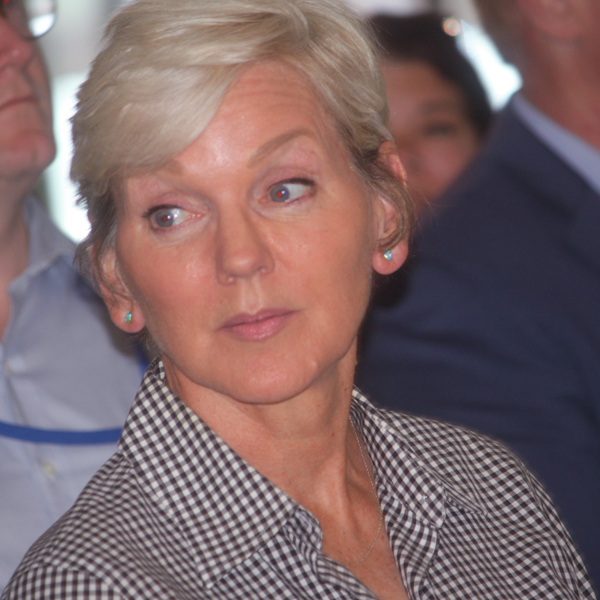
RICHLAND, Wash. — Business and political officials from southeastern Washington lobbied Energy Secretary Jennifer Granholm for a piece of the Biden administration’s clean energy spending last week during her tours of the Pacific Northwest National Laboratory and the nearby Hanford nuclear site.
Leaders from Washington’s Tri-Cities — Richland, Kennewick and Pasco — said the region would be a good place to nurture a center of a clean energy industry.
Washington state officials also want a piece of the $8 billion the federal government plans to award for regional hydrogen hub projects.
“Whether that will happen [in Washington]? I don’t know,” said U.S. Sen. Maria Cantwell (D-Wash.), who joined Granholm during Thursday’s visit to PNNL, where they were briefed on the lab’s clean energy technology projects.
 Energy Secretary Jennifer Granholm tours the Hanford Nuclear Site’s B Reactor, which produced the plutonium used in the atomic bomb dropped on Nagasaki, Japan. | © RTO Insider LLC
Energy Secretary Jennifer Granholm tours the Hanford Nuclear Site’s B Reactor, which produced the plutonium used in the atomic bomb dropped on Nagasaki, Japan. | © RTO Insider LLCGranholm, who visited the Hanford nuclear reservation on Friday, said it will be months before the Department Energy decides how to divide up the $8 billion. DOE expects to receive more than 100 proposals to create regional hydrogen production and distribution hubs by September, when the agency will begin winnowing the proposals to four to eight projects. Granholm declined to speculate on how long that selection process will take.
Granholm’s visit came just before the House on Friday approved the Inflation Reduction Act, which includes a long list of clean energy measures. (See What’s in the Inflation Reduction Act, Part 1.)
Implementing the law will be a huge task, Granholm said. “It’s deployment, deployment, deployment of clean energy.”
Granholm said the administration could seek additional legislation in the next couple years, such as tax credits for improvements to the nation’s power grid. “We are always trying to perfect things,” she said.
Washington’s Hydrogen Efforts
Washington’s first hydrogen production plant is expected to go online in central Washington’s East Wenatchee in mid-2023. The Port of Seattle is studying whether it wants to get into the hydrogen fuel business. Paccar, a truck manufacturer in the Seattle suburb of Renton, is testing 10 hydrogen-fueled semitrucks in Los Angeles. And public transit in Chehalis — south of Olympia — expects to start running hydrogen-fueled buses this year.
Fortescue Future Industries of East Perth, Australia, announced its intentions to build a hydrogen production facility next to the TransAlta coal-fired power plant in Centralia, also south of Olympia. So far, Fortescue has not announced any details on that plan. The TransAlta plant is due to close in 2025.
Gov. Jay Inslee has led the state’s lobbying efforts for the hydrogen funding, citing Washington’s intense efforts to shrink its carbon footprint.
The Washington legislature made several decisions this past session to support these efforts. Lawmakers allocated $2 million to lobby for hydrogen projects. They created an office of renewable fuels within the Washington Department of Commerce and some new tax breaks for renewable energy projects.
In 2021, the global hydrogen market was estimated at $130 billion and was expected to expand 6.4% annually, according to a report by Grand View Research, a San Francisco marketing research firm. And a February 2022 report by Goldman Sachs said, “Our global … hydrogen scenarios all show stellar growth of the clean hydrogen economy.”
‘This is the Place’
Hanford and Tri-Cities leaders also lobbied Granholm and Cantwell hard on the concept of a clean energy development center in the southeastern high-tech community. The Tri-Cities has pushed on the energy center concept for roughly a quarter of a century, with sporadic progress.
Karl Dye, executive director of the Tri-Cities Industrial Development Council, and others noted the Tri-Cities are within 30 miles of a nuclear power plant, three hydroelectric dams, several proposed solar panel farms and some wind turbines. “We have some of the cheapest, greenest energy in the country,” Dye said.
“If you want a good demonstration on if this could work? Here. This is the place,” said Bob Schuetz, executive director of Energy Northwest, which operates the 1,200-MW Columbia Generating Station north of Richland. Energy Northwest also has a 4-MW solar farm in northern Richland and plans to start building a 145-MW solar farm near the Columbia nuclear plant in January 2023, with completion expected in early 2024.
Another six solar panel farms are being developed in the Yakima River Valley 20 to 40 miles west and northwest of the Tri-Cities.
However, a wind farm proposed for the hills just south of the Tri-Cities has drawn controversy because many Tri-Citians don’t want turbines in their views of the southern skyline.
Energy Northwest is in discussions with small modular reactor developers about getting involved with one of those projects.
“I like this notion of switching from [nuclear] cleanup to power,” Granholm said.

